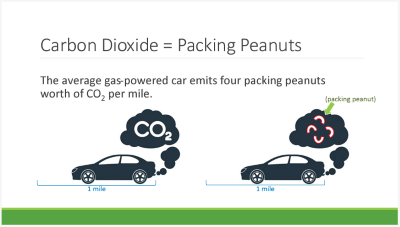“Counting Carbon” to Combat Climate Change
By Dr. Megan J. Sulsberger, CSU Monterey Bay
Teaching children about climate change is crucial for developing environmentally conscious citizens equipped to address a changing planet and promote sustainability.
In my recent CASE session, STEM-Based Activities for Young Ecologists, participants explored Population Education’s interactive, standards-aligned lesson, Counting Carbon, which effectively empowers students to understand and advocate for environmental protection.

In the first part of our session, we used biodegradable starch packing peanuts to visualize CO2 emissions from students’ transportation to school, with each mile equaling four peanuts for an average gas-powered car. This exercise helped calculate emissions for a class and sparked discussions about lower-emission travel options, challenges to changing habits, and future transportation ideas. Participants agreed that incorporating carbon use into lessons deepens understanding of climate change and could empower students to make small, impactful behavioral changes.
In the second part of the session, we created carbon sink models to show how natural areas like oceans, wetlands, grasslands, and forests absorb and store CO2. Using clear containers with water, we calculated how much CO2 these sinks could absorb from our imaginary class’s emissions, while also demonstrating that some CO2 remains in the atmosphere. This led to discussions about reducing CO2 emissions and protecting natural carbon sinks. Participants agreed this activity helps students understand how human actions drive climate change and the importance of collective action. It also encourages critical thinking by exploring scientific data, ethical considerations, and potential solutions. Such lessons can spark broader discussions about systemic approaches to climate change, including renewable energy, sustainable agriculture, and government policies.
Overall, this CASE session highlighted that teaching climate change in schools can empower students rather than overwhelm them. Building knowledge fosters environmental understanding, connection, and action. By introducing practical ways to reduce carbon footprints and demonstrating individual impact, educators can inspire a sense of agency. Teaching about climate change also emphasizes the role of innovation and creativity in addressing the crisis, opening doors to careers in renewable energy, environmental science, and sustainability. These lessons go beyond education—they are a call to environmental consciousness.
About the Author

Dr. Megan J. Sulsberger, Associate Professor in the Department of Education and Leadership at California State University Monterey Bay (CSUMB), specializes in Science Education and Ecological Literacy. She holds a Ph.D. in Curriculum and Instruction from Virginia Tech and an M.Ed. in Environmental Education from Slippery Rock University. At CSUMB, she teaches K-8 Science Methods, supervises teacher candidates in three school districts, and leads professional development to enhance STEM readiness and ecological literacy for PK-12 educators. A Population Education Teacher Trainer since 2016, Dr. Sulsberger is committed to advancing environmental education.
Population Education is a national program offering curriculum resources and professional development for K-12 educators on human population growth and its environmental and social impacts. Their hands-on, innovative lesson plans and training empower educators to teach these critical topics effectively. Learn more at Population Education.






